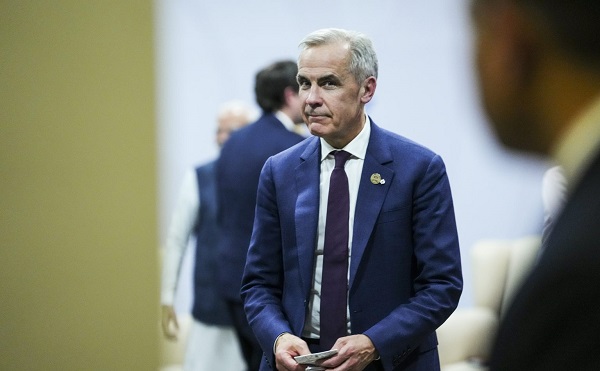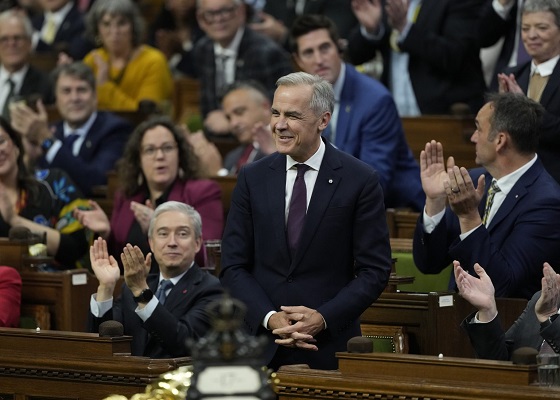Uncategorized
Putin sternly warns US against putting missiles in Europe

MOSCOW — Russian President Vladimir Putin sternly warned the United States against deploying new missiles in Europe, saying Wednesday that Russia will retaliate by fielding new weapons that will take just as little time to reach their targets.
While the Russian leader didn’t say what specific new weapons Moscow could deploy, his statement further raised the ante in tense relations with Washington.
Speaking in his state-of-the-nation address, Putin charged that the U.S. has abandoned a key arms control pact to free up its hands to build new missiles and tried to shift the blame for the move to Russia.
“Our American partners should have honestly said it instead of making unfounded accusations against Russia to justify their withdrawal from the treaty,” Putin said.
The U.S. has accused Russia of breaching the 1987 Intermediate-Range Nuclear Forces treaty by deploying a cruise missile that violates its limits — the accusations Moscow has rejected.
The INF treaty banned production, testing and deployment of land-based cruise and ballistic missiles with a range of 500 to 5,500
The intermediate-range weapons were seen as particularly destabilizing as they take shorter time to reach their targets compared to the intercontinental ballistic missiles. That would leave practically no time for decision-makers, raising the likelihood of a global nuclear conflict over a false launch warning.
Putin reaffirmed that Russia will not be the first to deploy new intermediate-range missiles but warned of a quick retaliation if the U.S. puts such weapons in Europe.
“They will only take 10-12 minutes to reach Moscow,” he said. “It’s a very serious threat to us, and we will have to respond.”
He didn’t directly mention the U.S., but noted that the Russian response will be “asymmetrical” and involve new weapons will reach the enemy’s decision-making
“Russia will be forced to create and deploy new types of weapons that could be used not only against the territories where a direct threat to us comes from, but also against the territories where decision-making
The president didn’t specify which of the prospective Russian weapons will do the job, but he reported a quick progress on an array of new weapons presented a year ago.
The Russian leader said the first batch of Avangard hypersonic glide vehicles will be deployed this year. Putin said the development of a vehicle that the military said is capable of flying 27 times faster than the speed of sound was a technological achievement comparable to the 1957 Soviet launch of the first satellite.
He added that the tests of the new Sarmat heavy intercontinental ballistic missile, the Burevestnik nuclear-powered cruise missile and the Poseidon nuclear-powered underwater drone have been progressing successfully.
Putin said the first submarine equipped to carry the Poseidon will be commissioned later this year. Shortly after Putin’s speech, the
Putin also announced the coming deployment of the new Zircon hypersonic missile for the Russian navy, saying it’s capable of flying at nine times the speed of sound and will have a range of 1,000
He said the Zircon program will not be too costly as the missile has been designed to equip Russia’s existing surface ships and submarines.
Putin added that the military will deploy more Kinzhal airborne hypersonic missiles, which entered service last year. The
Putin urged U.S. officials to take into account the “range and speed of our prospective weapons” before making decisions that will threaten Russia.
“We are only asking about one thing: Do the count first before making decisions that could create new serious threats against our country and would trigger retaliatory measures,” he said.
While issuing a tough warning to the U.S., Putin also claimed that Russia still wants friendly relations with Washington and remains open for arms control talks.
“We don’t want confrontation, particularly with such a global power as the U.S.,” he said.
At the same time, he criticized what he described as “destructive” U.S. policy of targeting Russia with sanctions.
Russia’s relations with the U.S. have sunk to post-Cold War lows over Russia’s 2014 annexation of Ukraine’s Crimean Peninsula, its support for the Syrian government in the war in Syria and the allegations of Russian meddling in the 2016 U.S. presidential election.
The menacing talk about new weapons and the tough warnings aimed at the U.S. followed a speech that mostly focused on domestic issues.
Putin promised Russians that he would raise welfare payments, improve education and the struggling health care system and remove toxic dump sites from cities. Similar goals have been set before, but the progress has been slow as Russia has been buffeted by economic shocks caused by a drop in oil prices and Western sanctions.
Vladimir Isachenkov, The Associated Press
Uncategorized
Cost of bureaucracy balloons 80 per cent in 10 years: Public Accounts

The cost of the bureaucracy increased by $6 billion last year, according to newly released numbers in Public Accounts disclosures. The Canadian Taxpayers Federation is calling on Prime Minister Mark Carney to immediately shrink the bureaucracy.
“The Public Accounts show the cost of the federal bureaucracy is out of control,” said Franco Terrazzano, CTF Federal Director. “Tinkering around the edges won’t cut it, Carney needs to take urgent action to shrink the bloated federal bureaucracy.”
The federal bureaucracy cost taxpayers $71.4 billion in 2024-25, according to the Public Accounts. The cost of the federal bureaucracy increased by $6 billion, or more than nine per cent, over the last year.
The federal bureaucracy cost taxpayers $39.6 billion in 2015-16, according to the Public Accounts. That means the cost of the federal bureaucracy increased 80 per cent over the last 10 years. The government added 99,000 extra bureaucrats between 2015-16 and 2024-25.
Half of Canadians say federal services have gotten worse since 2016, despite the massive increase in the federal bureaucracy, according to a Leger poll.
Not only has the size of the bureaucracy increased, the cost of consultants, contractors and outsourcing has increased as well. The government spent $23.1 billion on “professional and special services” last year, according to the Public Accounts. That’s an 11 per cent increase over the previous year. The government’s spending on professional and special services more than doubled since 2015-16.
“Taxpayers should not be paying way more for in-house government bureaucrats and way more for outside help,” Terrazzano said. “Mere promises to find minor savings in the federal bureaucracy won’t fix Canada’s finances.
“Taxpayers need Carney to take urgent action and significantly cut the number of bureaucrats now.”
Table: Cost of bureaucracy and professional and special services, Public Accounts
| Year | Bureaucracy | Professional and special services |
|
$71,369,677,000 |
$23,145,218,000 |
|
|
$65,326,643,000 |
$20,771,477,000 |
|
|
$56,467,851,000 |
$18,591,373,000 |
|
|
$60,676,243,000 |
$17,511,078,000 |
|
|
$52,984,272,000 |
$14,720,455,000 |
|
|
$46,349,166,000 |
$13,334,341,000 |
|
|
$46,131,628,000 |
$12,940,395,000 |
|
|
$45,262,821,000 |
$12,950,619,000 |
|
|
$38,909,594,000 |
$11,910,257,000 |
|
|
$39,616,656,000 |
$11,082,974,000 |
Uncategorized
Trump Admin Establishing Council To Make Buildings Beautiful Again


From the Daily Caller News Foundation
By Jason Hopkins
The Trump administration is creating a first-of-its-kind task force aimed at ushering in a new “Golden Age” of beautiful infrastructure across the U.S.
The Department of Transportation (DOT) will announce the establishment of the Beautifying Transportation Infrastructure Council (BTIC) on Thursday, the Daily Caller News Foundation exclusively learned. The BTIC seeks to advise Transportation Secretary Sean Duffy on design and policy ideas for key infrastructure projects, including highways, bridges and transit hubs.
“What happened to our country’s proud tradition of building great, big, beautiful things?” Duffy said in a statement shared with the DCNF. “It’s time the design for America’s latest infrastructure projects reflects our nation’s strength, pride, and promise.”
“We’re engaging the best and brightest minds in architectural design and engineering to make beautiful structures that move you and bring about a new Golden Age of Transportation,” Duffy continued.
Mini scoop – here is the DOT’s rollout of its Beautifying Transportation Infrastructure Council, which will be tasked with making our buildings beautiful again. pic.twitter.com/
9iV2xSxdJM — Jason Hopkins (@jasonhopkinsdc) October 23, 2025
The DOT is encouraging nominations of the country’s best architects, urban planners, artists and others to serve on the council, according to the department. While ensuring that efficiency and safety remain a top priority, the BTIC will provide guidance on projects that “enhance” public areas and develop aesthetic performance metrics.
The new council aligns with an executive order signed by President Donald Trump in August 2025 regarding infrastructure. The “Making Federal Architecture Beautiful Again” order calls for federal public buildings in the country to “respect regional architectural heritage” and aims to prevent federal construction projects from using modernist and brutalist architecture styles, instead returning to a classical style.
“The Founders, in line with great societies before them, attached great importance to Federal civic architecture,” Trump’s order stated. “They wanted America’s public buildings to inspire the American people and encourage civic virtue.”
“President George Washington and Secretary of State Thomas Jefferson consciously modeled the most important buildings in Washington, D.C., on the classical architecture of ancient Athens and Rome,” the order continued. “Because of their proven ability to meet these requirements, classical and traditional architecture are preferred modes of architectural design.”
The DOT invested millions in major infrastructure projects since Trump’s return to the White House. Duffy announced in August a $43 million transformation initiative of the New York Penn Station in New York City and in September unveiledmajor progress in the rehabilitation and modernization of Washington Union Station in Washington, D.C.
The BTIC will comprise up to 11 members who will serve two-year terms, with the chance to be reappointed, according to the DOT. The task force will meet biannually. The deadline for nominations will end Nov. 21.
-

 Business21 hours ago
Business21 hours agoFederal major projects list raises questions
-

 International2 days ago
International2 days agoBoris Johnson Urges Ukraine to Continue War
-

 Great Reset2 days ago
Great Reset2 days agoRCMP veterans’ group promotes euthanasia presentation to members
-

 Health1 day ago
Health1 day agoOrgan donation industry’s redefinitions of death threaten living people
-

 Artificial Intelligence1 day ago
Artificial Intelligence1 day agoGoogle denies scanning users’ email and attachments with its AI software
-

 Business2 days ago
Business2 days agoTaxpayers paying wages and benefits for 30% of all jobs created over the last 10 years
-

 Business2 days ago
Business2 days agoIs affirming existing, approved projects truly the best we can do in Canada?
-

 MAiD2 days ago
MAiD2 days agoHealth Canada suggests MAiD expansion by pre-approving ‘advance requests’










